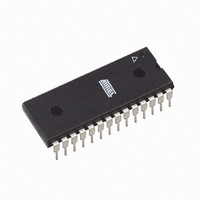ATMEGA8L-8PC Atmel, ATMEGA8L-8PC Datasheet - Page 26

ATMEGA8L-8PC
Manufacturer Part Number
ATMEGA8L-8PC
Description
IC AVR MCU 8K LV 8MHZ COM 28-DIP
Manufacturer
Atmel
Series
AVR® ATmegar
Specifications of ATMEGA8L-8PC
Core Processor
AVR
Core Size
8-Bit
Speed
8MHz
Connectivity
I²C, SPI, UART/USART
Peripherals
Brown-out Detect/Reset, POR, PWM, WDT
Number Of I /o
23
Program Memory Size
8KB (4K x 16)
Program Memory Type
FLASH
Eeprom Size
512 x 8
Ram Size
1K x 8
Voltage - Supply (vcc/vdd)
2.7 V ~ 5.5 V
Data Converters
A/D 6x10b
Oscillator Type
Internal
Operating Temperature
0°C ~ 70°C
Package / Case
28-DIP (0.300", 7.62mm)
Lead Free Status / RoHS Status
Contains lead / RoHS non-compliant
Other names
ATMEGA8L8PC
Available stocks
Company
Part Number
Manufacturer
Quantity
Price
Company:
Part Number:
ATMEGA8L-8PC
Manufacturer:
TI
Quantity:
2 154
- Current page: 26 of 302
- Download datasheet (6Mb)
Asynchronous Timer
Clock – clk
ADC Clock – clk
Clock Sources
26
ATmega8(L)
ASY
ADC
The Asynchronous Timer clock allows the Asynchronous Timer/Counter to be clocked directly
from an external 32kHz clock crystal. The dedicated clock domain allows using this Timer/Coun-
ter as a real-time counter even when the device is in sleep mode. The Asynchronous
Timer/Counter uses the same XTAL pins as the CPU main clock but requires a CPU main clock
frequency of more than four times the Oscillator frequency. Thus, asynchronous operation is
only available while the chip is clocked on the Internal Oscillator.
The ADC is provided with a dedicated clock domain. This allows halting the CPU and I/O clocks
in order to reduce noise generated by digital circuitry. This gives more accurate ADC conversion
results.
The device has the following clock source options, selectable by Flash Fuse Bits as shown
below. The clock from the selected source is input to the AVR clock generator, and routed to the
appropriate modules.
Table 2. Device Clocking Options Select
Note:
The various choices for each clocking option is given in the following sections. When the CPU
wakes up from Power-down or Power-save, the selected clock source is used to time the start-
up, ensuring stable Oscillator operation before instruction execution starts. When the CPU starts
from reset, there is as an additional delay allowing the power to reach a stable level before com-
mencing normal operation. The Watchdog Oscillator is used for timing this real-time part of the
start-up time. The number of WDT Oscillator cycles used for each time-out is shown in
The frequency of the Watchdog Oscillator is voltage dependent as shown in “ATmega8 Typical
Characteristics”. The device is shipped with CKSEL = “0001” and SUT = “10” (1MHz Internal RC
Oscillator, slowly rising power).
Table 3. Number of Watchdog Oscillator Cycles
Device Clocking Option
External Crystal/Ceramic Resonator
External Low-frequency Crystal
External RC Oscillator
Calibrated Internal RC Oscillator
External Clock
Typical Time-out (V
1. For all fuses “1” means unprogrammed while “0” means programmed
4.1ms
65ms
CC
= 5.0V)
Typical Time-out (V
(1)
4.3ms
69ms
CC
= 3.0V)
Number of Cycles
64K (65,536)
4K (4,096)
1111 - 1010
1000 - 0101
0100 - 0001
CKSEL3..0
1001
0000
2486Z–AVR–02/11
Table
3.
Related parts for ATMEGA8L-8PC
Image
Part Number
Description
Manufacturer
Datasheet
Request
R

Part Number:
Description:
8-bit AVR with 8K Bytes In-System Programmable Flash
Manufacturer:
ATMEL [ATMEL Corporation]
Datasheet:

Part Number:
Description:
IC AVR MCU 8K 8MHZ 3V 32-QFN
Manufacturer:
Atmel
Datasheet:

Part Number:
Description:
IC AVR MCU 8K 8MHZ 3V 28DIP
Manufacturer:
Atmel
Datasheet:

Part Number:
Description:
IC AVR MCU 8K LV 8MHZ COM 32TQFP
Manufacturer:
Atmel
Datasheet:

Part Number:
Description:
IC AVR MCU 8K LV 8MHZ IND 32TQFP
Manufacturer:
Atmel
Datasheet:

Part Number:
Description:
IC AVR MCU 8K LV 8MHZ IND 28-DIP
Manufacturer:
Atmel
Datasheet:

Part Number:
Description:
IC AVR MCU 8K LV 8MHZ COM 32-QFN
Manufacturer:
Atmel
Datasheet:

Part Number:
Description:
IC AVR MCU 8K LV 8MHZ IND 32-QFN
Manufacturer:
Atmel
Datasheet:

Part Number:
Description:
MCU AVR 8KB FLASH 8MHZ 32TQFP
Manufacturer:
Atmel
Datasheet:

Part Number:
Description:
MCU AVR 8KB FLASH 8MHZ 32QFN
Manufacturer:
Atmel
Datasheet:

Part Number:
Description:
IC MCU AVR 8K 5V 8MHZ 32-TQFP
Manufacturer:
Atmel
Datasheet:

Part Number:
Description:
IC MCU AVR 8K 5V 8MHZ 32-QFN
Manufacturer:
Atmel
Datasheet:

Part Number:
Description:
IC MCU AVR 8K 5V 8MHZ 28-DIP
Manufacturer:
Atmel
Datasheet:












